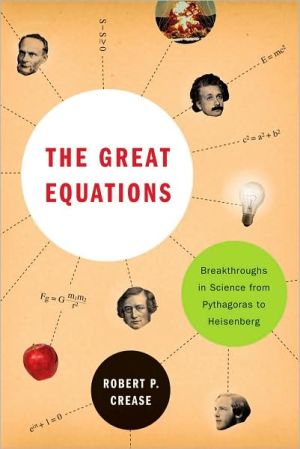

 |

|

The average rating for The Great Equations: Breakthroughs in Science from Pythagoras to Heisenberg based on 2 reviews is 3.5 stars.
Review # 1 was written on 2011-09-13 00:00:00 Ador Galendez Ador GalendezThe Great Equations is a science and mathematics book for popular readers, which is its strength and its weakness. The strength is that the text is accessible to just about any reader with some smattering of science and mathematics in their schooling. The weakness is that sometimes I found it a little too basic and too quick to gloss over details and proofs for equations. One of the interesting things is how the book demonstrates the way science progresses in fits and starts. It also shows how important collaboration and communication are to scientific discoveries. The other thread of the book that I enjoyed is its commitment that science is something that everyone should know something about -- the chapter on the Second Law of Thermodynamics, the law of entropy, is entitled "The Scientific equivalent of Shakespeare." He thinks we would all have better lives if we treated some basic scientific knowledge like we would knowing about Shakespeare. Crease is not shy to deride things like astrology. Crease also acknowledges his debt to the "Two Cultures" concept first proposed by C.P. Snow that says knowledge is divided into technical and cultural knowledge essentially. One of the most interesting chapters is the interlude that discusses the humanities and the science. "For only when the humanities couple their inquiries into human dimensions and possibilities with an awareness of what science has disclosed of the dimensions and possibilities of the world will the humanities most effectively be able to provide answers to the questions of what we know, should do, and can hope for." I enjoyed the chapters on quantum mechanics because they explained things in a way that helped me make sense of things friends of mine who are scientists and mathematicians have explained to me in other ways. One of the things missing from this book, as another reviewer pointed out, is the quadratic equation. I also would have liked to see mote mathematical proofs in the book. I think Crease missed a chance to make popular readers more comfortable with equations beyond just holding them up as something to be admired. I also would have liked to see a proof of the Pythagorean Theorem associated with the diagram associated with the U.S. President James A. Garfield used to invent a proof. I don't think enough information is given in the book to recreate the proof myself, though I may need to try again. I would recommend this book to anyone interested in the history of science, humanities and social science people, and educators who might draw some ideas on how to bring science and math to a wider audience. |
Review # 2 was written on 2017-07-22 00:00:00 Jocelyn Gagnon Jocelyn GagnonExcellent presentation of the history behind ten of the most famous equations in science. I would have liked more technical detail. I can see glossing over the derivation of a physical law involving tensor calculus, but Pythagoras's own proof of his famous theorem should be within the grasp of this book's audience. |
CAN'T FIND WHAT YOU'RE LOOKING FOR? CLICK HERE!!!